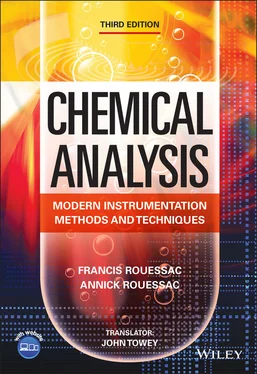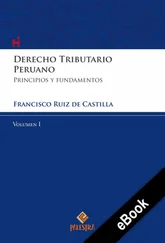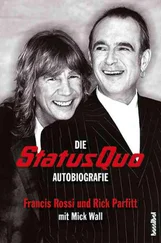11 Chapter 11Figure 11.1 Representation, as an energy diagram, of the absorption of a pho...Figure 11.2 Jablonski diagram. According to quantum theory, fluorescence res...Figure 11.3 Representation on the same graph of the absorbance and fluoresce...Figure 11.4 Fluorescing aromatic compounds. The compound names are followed ...Figure 11.5 Fluorescence intensity. Depending on the site in the solution wh...Figure 11.6 Fluorescence intensity and concentration. Modelling of Eq. (11.7...Figure 11.7 The various components of a fluorescence spectrum. The position ...Figure 11.8 Block diagram of a spectrofluorometer with a xenon arc lamp. The...Figure 11.9 Diagram of the optical path of a fluorescence microplate reader....Figure 11.10 Diagram of a Shimadzu F‐4500 spectrofluorometer. A fraction of ...Figure 11.11 Fluorescence spectra. Above, emission–excitation matrix of a mi...Figure 11.12 Representation of fluorescence decay and the principle of measu...Figure 11.13 Protein assay by chemifluorescence in biochemistry. The diagram...Figure 11.14 Comparison of UV and fluorescence detection following a chromat...Figure 11.15 Examples of chemiluminescence reactions. The nature of the reac...Figure 11.16 Nitrogen analyser using chemiluminescence. Stoichiometric react...Figure 11.17 Chemiluminescence reactions using ozone. The transformation of ...
12 Chapter 12Figure 12.1 X‐ray fluorescence, Auger emission, and Compton scattering. X‐ra...Figure 12.2 Simplified diagram of the source of some fluorescence transition...Figure 12.3 X‐ray generators. (a) Diagram of a classic X‐ray tube with water...Figure 12.4 Radioactive source 55Fe. Emission spectrum obtained by placing a...Figure 12.5 Pear‐shaped interaction of the electron beam with the material. ...Figure 12.6 Various detectors used in X‐ray fluorescence spectrometry. (a) P...Figure 12.7 The two acquisition modes of X‐ray spectra. The energy detection...Figure 12.8 Energy‐dispersive X‐ray fluorescence spectrometer. Arrangement o...Figure 12.9 Reflecting crystals used in goniometers of wavelength‐dispersive...Figure 12.10 Crystal‐based sequential spectrometers. Above, a diagram inspir...Figure 12.11 X‐ray densitometry –percentage transmission for two films made ...Figure 12.12 ED‐XRF portable field apparatus. (a) Spectometer SPECTRO‐X Sort...Figure 12.13 Spectrum of a surface sample from Mars, obtained by the Mars Ro...
13 Chapter 13Figure 13.1 Kirchhoff ’s experiment on the reversal of lines. The convention...Figure 13.2 Some energy levels of the sodium atom. Simplified representation...Figure 13.3 Summary of the possible evolution of an aerosol solution in a fl...Figure 13.4 Examples of calibration graphs in AAS. Left, a straight calibrat...Figure 13.5 The various components of a single‐beam atomic absorption appara...Figure 13.6 Two types of sources in AAS. The cathode is a hollow cylinder wh...Figure 13.7 Comparison of transmitted intensities in AAS with a continuum li...Figure 13.8 Burner and thermoelectric atomization system. (a), (b) Graphite ...Figure 13.9 Diagram of a hydride reactor. Reserved for certain elements, thi...Figure 13.10 Matrix modification. Ammonium nitrate or EDTA increases the vol...Figure 13.11 Diagram of an AA spectrometer showing background correction wit...Figure 13.12 Normal Zeeman effect. Pictorial explanation of the constant inv...Figure 13.13 Correction using a pulsed lamp. Profiles of an emission line in...Figure 13.14 Elements measured by AAS.
14 Chapter 14Figure 14.1 Basic design of an atomic emission spectrometer.Figure 14.2 Energy transitions in atomic emission. For every atom, there are...Figure 14.3 Plasma torch obtained by inductive coupling. Plasma torch repres...Figure 14.4 Nebulizers. Models: cross‐path (1), concentric (2) and parallel ...Figure 14.5 Laser and glow discharge excitation instruments. (a) By laser (L...Figure 14.6 Atomic spectrometry using plasma induced by laser. Two models of...Figure 14.7 Three fundamental causes of atomic line broadening. Representati...Figure 14.8 Optical diagram of an instrument with a concave grating and a po...Figure 14.9 Principle of dispersion in the focal plane of an assembly combin...Figure 14.10 Optical diagram for a spectrophotometer with an echelle grating...Figure 14.11 Linear dispersion and reciprocal linear dispersion (inverse dis...Figure 14.12 Analysis of a sample of Mars soil by atomic emission after lase...Figure 14.13 Flame photometry. Basic diagram of a flame photometer and list ...
15 Chapter 15Figure 15.1 Conventional representation of the 1H NMR spectrum of an organic...Figure 15.2 Effect of a magnetic field upon a nucleus of spin number ½ for a...Figure 15.3 Representation of the energy differences for a nucleus with a sp...Figure 15.4 Precession and magnetization. (a) A snapshot illustrating the pr...Figure 15.5 NMR spectrum of a water sample placed in a borosilicate glass co...Figure 15.6 Representation of an electromagnetic wave and its effect on a nu...Figure 15.7 Deviation of the magnetization vector  and return to equilibri...Figure 15.8 FID signal of fluoroacetone ( 13C) obtained with a pulsed wave ap...Figure 15.9 CW‐NMR apparatus. Arrangement of the different coils around the ...Figure 15.10 The two processes of nuclear relaxation. Evolution of spin–spin...Figure 15.11 Chemical shifts of certain compounds in proton NMR. Shielding e...Figure 15.12 Effects of resonance for carbonyl compounds in 13C NMR. If the ...Figure 15.13 Anisotropic effects and induced local fields. The presence of π ...Figure 15.14 Heteronuclear spin‐spin coupling of hydrogen fluoride.Figure 15.15 Coupling diagram for the HF molecule in 1H NMR. Hypothetical co...Figure 15.16 Representation of the different spin states for the five proton...Figure 15.17 Spectrum of the four aromatic protons of aspirin. The figure ab...Figure 15.18 Characteristics defining an AB system. (a–d) Gradual modificati...Figure 15.19 Nomenclature of NMR spectra. The 1H spectrum of 3‐chloro‐4‐meth...Figure 15.20 Spin decoupling experiment on butanone. Modification of the 1H ...Figure 15.21 DEPT sequence on 2‐carene. This example illustrates what these ...Figure 15.22 13C spectra of CDCl 3and CD 2Cl 2. Deuterium, for which I = 1, le...Figure 15.23 COSY spectrum of 3‐heptanone. On this representation, on a give...Figure 15.24 NOESY spectrum of ethylbenzene. The result of a NOESY experimen...Figure 15.25 13C spectrum of ethylbenzene decoupled from protons and HSQC sp...Figure 15.26 NMR spectra of monofluoroacetone. An example of heteronuclear c...Figure 15.27 Positions of some NMR signals due to fluorine and phosphorus.Figure 15.28 Recording obtained from an experiment using coupled HPLC‐ 1H NMR...Figure 15.29 NMR spectrum of a mixture of acetone (A) and benzene (B). If S AFigure 15.30 Spectrum of a sample to which a reference compound R has been a...Figure 15.31 Determination of the solid fat index by means of decrease in FI...Figure 15.32 Inside view of a kiwi fruit. One of these images is a photo of ...Figure P15.1
and return to equilibri...Figure 15.8 FID signal of fluoroacetone ( 13C) obtained with a pulsed wave ap...Figure 15.9 CW‐NMR apparatus. Arrangement of the different coils around the ...Figure 15.10 The two processes of nuclear relaxation. Evolution of spin–spin...Figure 15.11 Chemical shifts of certain compounds in proton NMR. Shielding e...Figure 15.12 Effects of resonance for carbonyl compounds in 13C NMR. If the ...Figure 15.13 Anisotropic effects and induced local fields. The presence of π ...Figure 15.14 Heteronuclear spin‐spin coupling of hydrogen fluoride.Figure 15.15 Coupling diagram for the HF molecule in 1H NMR. Hypothetical co...Figure 15.16 Representation of the different spin states for the five proton...Figure 15.17 Spectrum of the four aromatic protons of aspirin. The figure ab...Figure 15.18 Characteristics defining an AB system. (a–d) Gradual modificati...Figure 15.19 Nomenclature of NMR spectra. The 1H spectrum of 3‐chloro‐4‐meth...Figure 15.20 Spin decoupling experiment on butanone. Modification of the 1H ...Figure 15.21 DEPT sequence on 2‐carene. This example illustrates what these ...Figure 15.22 13C spectra of CDCl 3and CD 2Cl 2. Deuterium, for which I = 1, le...Figure 15.23 COSY spectrum of 3‐heptanone. On this representation, on a give...Figure 15.24 NOESY spectrum of ethylbenzene. The result of a NOESY experimen...Figure 15.25 13C spectrum of ethylbenzene decoupled from protons and HSQC sp...Figure 15.26 NMR spectra of monofluoroacetone. An example of heteronuclear c...Figure 15.27 Positions of some NMR signals due to fluorine and phosphorus.Figure 15.28 Recording obtained from an experiment using coupled HPLC‐ 1H NMR...Figure 15.29 NMR spectrum of a mixture of acetone (A) and benzene (B). If S AFigure 15.30 Spectrum of a sample to which a reference compound R has been a...Figure 15.31 Determination of the solid fat index by means of decrease in FI...Figure 15.32 Inside view of a kiwi fruit. One of these images is a photo of ...Figure P15.1
16 Chapter 16Figure 16.1 Fragmentation spectrum and mass spectrum presented in graphical ...Figure 16.2 Diagram of mass spectrometer components.Figure 16.3 Resolving power. Left, definition of this parameter in the case ...Figure 16.4 Resolving power established using experimental spectra. Left, an...Figure 16.5 Interfacing between a separation method and mass spectrometry.Figure 16.6 Installation of a pumping system of a mass spectrometer. The tur...Figure 16.7 Turbomolecular pump. Basic diagram. The pumping effect is obtain...Figure 16.8 Electron ionization. The collision of an electron with a molecul...Figure 16.9 Influence of electron energy on fragmentation. An example with b...Figure 16.10 Chemical ionization. Formation of cationic species from methane...Figure 16.11 FAB and MALDI techniques. (a) The principle of formation of a f...Figure 16.12 Atmospheric pressure ionization by electrospray (ion spray). Th...Figure 16.13 Atmospheric pressure chemical ionization. (1) The sample soluti...Figure 16.14 Multicharged molecular ions. A spectrum obtained from cytochrom...Figure 16.15 Representation of the appropriate ranges for the main ionizatio...Figure 16.16 A 180° magnetic deflection spectrograph with a velocity filter....Figure 16.17 An instrument designed with a BE‐type electromagnetic analyser....Figure 16.18 Influence of the accelerating voltage upon the range of velocit...Figure 16.19 Layout of a double‐focusing EB mass spectrometer. R’ and R meas...Figure 16.20 A simplified diagram of a time‐of‐flight spectrometer and the p...Figure 16.21 Diagram of a linear quadrupole. Notice the connection of bars t...Figure 16.22 Quadrupole filter. Depending upon their mass, the ions respond ...Figure 16.23 Example of residual gases in a strong vacuum. The recording is ...Figure 16.24 Ion‐trap spectrometers. (a) Design of the electrodes in an ion ...Figure 16.25 Introduction (a), confinement (b), and ejection (c) of ions in ...Figure 16.26 The principle of ICRMS. (a) Basic ion trajectory subject to mag...Figure 16.27 A triple quadrupole (MS/MS). In this assembly, called QQQ, the ...Figure 16.28 MS detectors. (a) Discrete dynode model with active film(b)...Figure 16.29 Spectral profile of an antibody of high molecular mass. This sp...Figure 16.30 Fragmentation spectrum of butanone obtained by electron ionizat...Figure 16.31 Fragmentation modes of an ether, with diethyl ether taken as an...Figure 16.32 McLafferty rearrangement. Situation for butanal C 4H 8OFigure 16.33 Metastable ion peak. Theoretical appearance of the three peaks ...Figure 16.34 Metastable ion peaks observed during fragmentation of theobromi...Figure 16.35 Peptide bond cleavage. In this example of a tetrapeptide treate...Figure 16.36 Plasma torch ionization and recording obtained by the ICP/MS me...Figure P16.1 Figure P16.2 Figure P16.3 Figure P16.4 Figure P16.5
Читать дальше

 and return to equilibri...Figure 15.8 FID signal of fluoroacetone ( 13C) obtained with a pulsed wave ap...Figure 15.9 CW‐NMR apparatus. Arrangement of the different coils around the ...Figure 15.10 The two processes of nuclear relaxation. Evolution of spin–spin...Figure 15.11 Chemical shifts of certain compounds in proton NMR. Shielding e...Figure 15.12 Effects of resonance for carbonyl compounds in 13C NMR. If the ...Figure 15.13 Anisotropic effects and induced local fields. The presence of π ...Figure 15.14 Heteronuclear spin‐spin coupling of hydrogen fluoride.Figure 15.15 Coupling diagram for the HF molecule in 1H NMR. Hypothetical co...Figure 15.16 Representation of the different spin states for the five proton...Figure 15.17 Spectrum of the four aromatic protons of aspirin. The figure ab...Figure 15.18 Characteristics defining an AB system. (a–d) Gradual modificati...Figure 15.19 Nomenclature of NMR spectra. The 1H spectrum of 3‐chloro‐4‐meth...Figure 15.20 Spin decoupling experiment on butanone. Modification of the 1H ...Figure 15.21 DEPT sequence on 2‐carene. This example illustrates what these ...Figure 15.22 13C spectra of CDCl 3and CD 2Cl 2. Deuterium, for which I = 1, le...Figure 15.23 COSY spectrum of 3‐heptanone. On this representation, on a give...Figure 15.24 NOESY spectrum of ethylbenzene. The result of a NOESY experimen...Figure 15.25 13C spectrum of ethylbenzene decoupled from protons and HSQC sp...Figure 15.26 NMR spectra of monofluoroacetone. An example of heteronuclear c...Figure 15.27 Positions of some NMR signals due to fluorine and phosphorus.Figure 15.28 Recording obtained from an experiment using coupled HPLC‐ 1H NMR...Figure 15.29 NMR spectrum of a mixture of acetone (A) and benzene (B). If S AFigure 15.30 Spectrum of a sample to which a reference compound R has been a...Figure 15.31 Determination of the solid fat index by means of decrease in FI...Figure 15.32 Inside view of a kiwi fruit. One of these images is a photo of ...Figure P15.1
and return to equilibri...Figure 15.8 FID signal of fluoroacetone ( 13C) obtained with a pulsed wave ap...Figure 15.9 CW‐NMR apparatus. Arrangement of the different coils around the ...Figure 15.10 The two processes of nuclear relaxation. Evolution of spin–spin...Figure 15.11 Chemical shifts of certain compounds in proton NMR. Shielding e...Figure 15.12 Effects of resonance for carbonyl compounds in 13C NMR. If the ...Figure 15.13 Anisotropic effects and induced local fields. The presence of π ...Figure 15.14 Heteronuclear spin‐spin coupling of hydrogen fluoride.Figure 15.15 Coupling diagram for the HF molecule in 1H NMR. Hypothetical co...Figure 15.16 Representation of the different spin states for the five proton...Figure 15.17 Spectrum of the four aromatic protons of aspirin. The figure ab...Figure 15.18 Characteristics defining an AB system. (a–d) Gradual modificati...Figure 15.19 Nomenclature of NMR spectra. The 1H spectrum of 3‐chloro‐4‐meth...Figure 15.20 Spin decoupling experiment on butanone. Modification of the 1H ...Figure 15.21 DEPT sequence on 2‐carene. This example illustrates what these ...Figure 15.22 13C spectra of CDCl 3and CD 2Cl 2. Deuterium, for which I = 1, le...Figure 15.23 COSY spectrum of 3‐heptanone. On this representation, on a give...Figure 15.24 NOESY spectrum of ethylbenzene. The result of a NOESY experimen...Figure 15.25 13C spectrum of ethylbenzene decoupled from protons and HSQC sp...Figure 15.26 NMR spectra of monofluoroacetone. An example of heteronuclear c...Figure 15.27 Positions of some NMR signals due to fluorine and phosphorus.Figure 15.28 Recording obtained from an experiment using coupled HPLC‐ 1H NMR...Figure 15.29 NMR spectrum of a mixture of acetone (A) and benzene (B). If S AFigure 15.30 Spectrum of a sample to which a reference compound R has been a...Figure 15.31 Determination of the solid fat index by means of decrease in FI...Figure 15.32 Inside view of a kiwi fruit. One of these images is a photo of ...Figure P15.1


![Евгений Матерёв - Музеи… или вдохновляющая музыка The Chemical Brothers [litres самиздат]](/books/437288/evgenij-materev-muzei-ili-vdohnovlyayuchaya-muzyka-th-thumb.webp)







